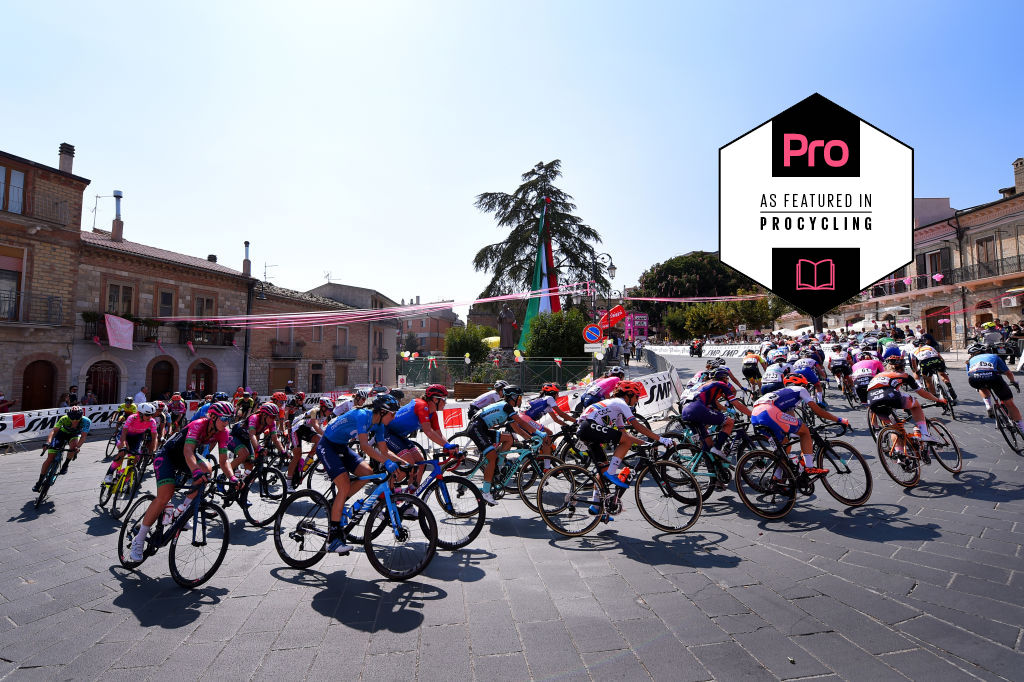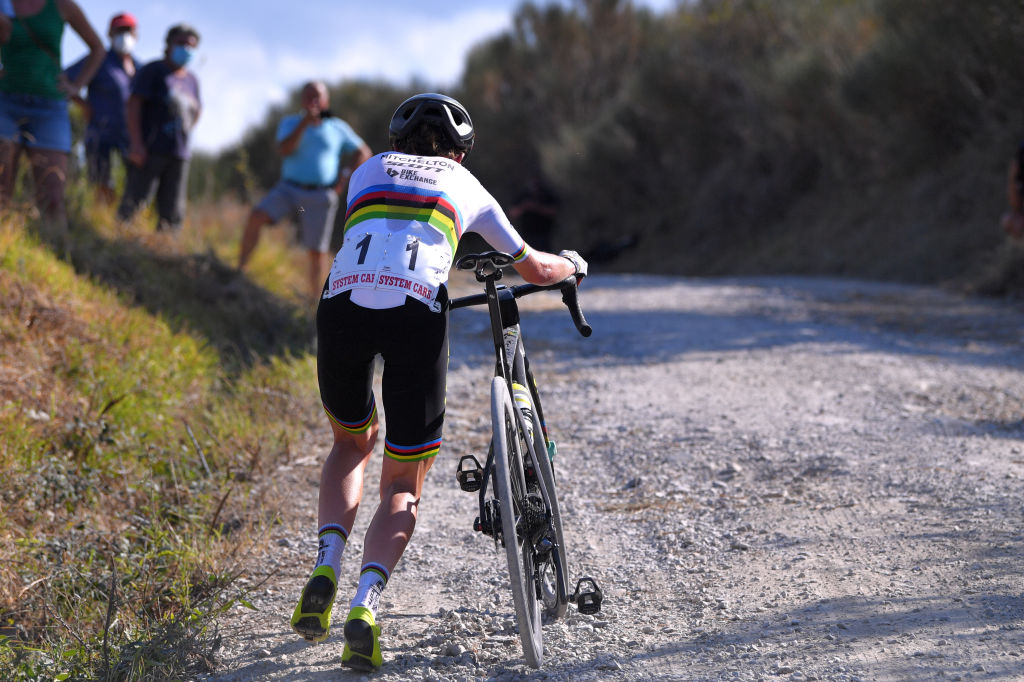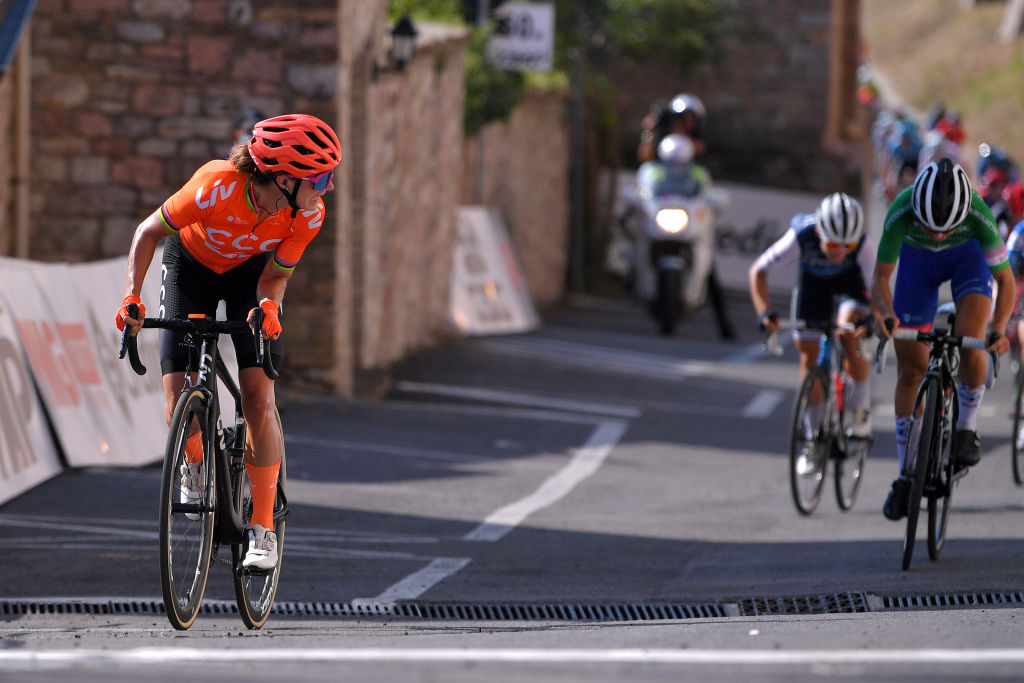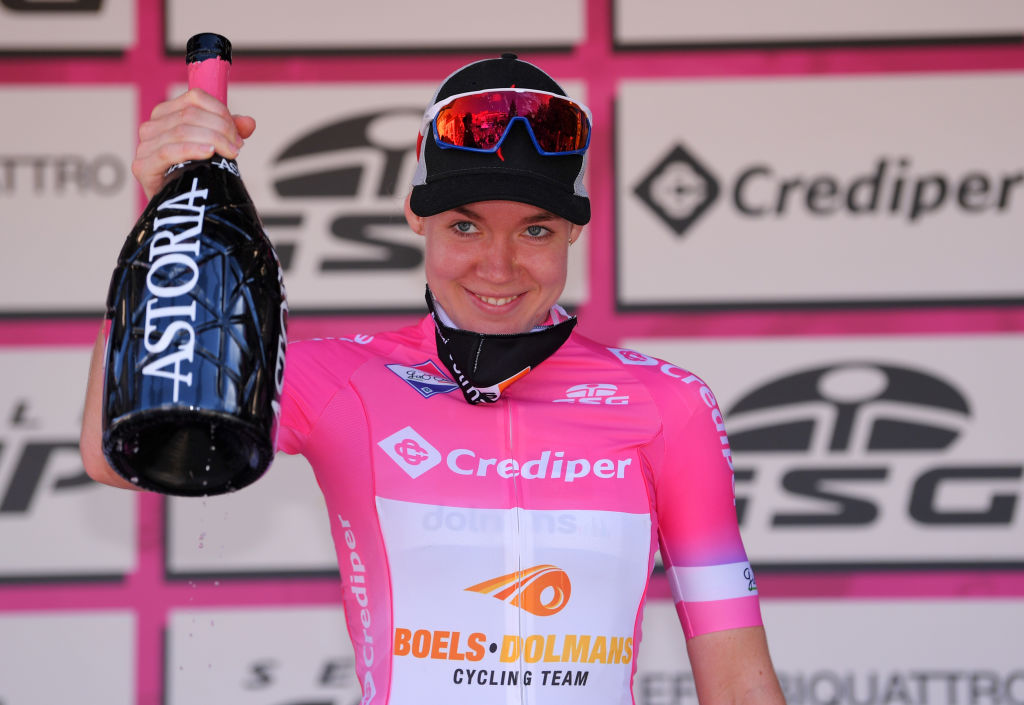Giro Rosa: fading glory
Procycling witnesses a 2020 edition that threatens its status as the most prestigious stage race on the women's calendar

The Giro Rosa has long been the most prestigious stage race on the women’s calendar. But with crashes, bad roads, tales of organisational difficulties and a lack of live TV, Procycling magazine witnessed a fascinating if restrained edition, that threatened its future status as number one.
Subscribe to Procycling magazine from just £3.47 per issue
This year’s Giro Rosa was all going so well for Annemiek van Vleuten. It was different from her two previous wins. There were none of the long Alpine climbs or individual time trials where she had made the difference before, but from the very start the Dutchwoman was in control, gliding serenely to a third consecutive overall victory.
She started stage 7 between Nola and Maddaloni defending an overall lead which had increased to 1-52 since she comprehensively won stage 2. But then, around 500 metres from the end, disaster.
The stage had been dynamic. The breakaway’s last survivor dispatched on the day’s final climb, and CCC-Liv’s Soraya Paladin led a group of around 25 women into the closing kilometre hoping team-mate Marianne Vos could win a fourth stage. But when the Italian swerved to avoid yet another pothole the ripple effect resulted in a crash, with Van Vleuten going down hard. She crossed the line on her bike, her left arm carried awkwardly by her side, climbing into an ambulance rather than onto the podium to celebrate another day in pink.
A few hours later it was confirmed that she had fractured her wrist.
The mood was sombre among those waiting behind the podium. Only stage winner Lotte Kopecky (Lotto-Soudal) cracked a smile, and Kasia Niewiadoma (Canyon-Sram), who was set to assume the overall lead in Van Vleuten’s absence, stood quietly, her brow furrowed.
Get The Leadout Newsletter
The latest race content, interviews, features, reviews and expert buying guides, direct to your inbox!
“It’s a tiny world and we all look after each other,” one rider said.
Poor roads had been an increasing problem as this year’s nine-day event headed south from the start in Tuscany into Campania, and eventual overall winner Anna van der Breggen voiced her concerns. “We’ve had bad roads already for days so actually we were quite surprised it was all fine until now,” Boels-Dolmans’ Olympic champion said. “We try to avoid the potholes in the road and yeah, if you are in the final you are close to the other girls, so it can happen.”
But there were other issues, with stage 6 perhaps the worst example. At the start in Torre del Greco team staff were seen sweeping litter from around their busses, and wise riders carried their bikes across the glass strewn car park to avoid punctures. The 11km neutral zone indicated in the roadbook, and announced on race radio as the peloton rolled, was shortened to around 4km without warning, and an intermediate sprint situated on a speed bump only 100m after a 90 degree turn on a roundabout was not untypical.
But the biggest criticism was the lack of live television. Unlike some other, even lower ranked, races which have been streamed for years, the Giro Rosa has never been broadcast live, and though its highlights package is now longer, this does not comply with WorldTour regulations.
“I think TV is even more important than the minimum wage,” said Sunweb’s Coryn Rivera. “You need to create value before you get value, but TV is the biggest thing to put us out there.”
Despite organisers managing to hold the race in the midst of the ongoing pandemic, shortly after the race ended the UCI confirmed the Giro Rosa will not be part of the 2021 WorldTour, citing “various shortcomings on the part of the organiser with regard to the specifications (particularly in terms of television coverage), despite repeated requests from us over the past few years”.

This is part of a bigger problem for the Giro Rosa. The race repeatedly struggles to promote itself, and though it often attracts decent crowds, local businesses are often unaware it even exists. For years it has been dogged by organisational issues, and sometimes seems like an amateur race with professional competitors.
Team parking is often an issue, and as recently as 2016 riders could be sharing rooms with three others with no air-conditioning (the race typically takes place in July). Despite improvements, it’s still way short of the standards now seen at other events, such as the UK’s Women’s Tour, and with ASO launching a French stage race in 2022 it faces an existential threat in its status as the number one stage race on the calendar.
However, the Giro Rosa offers what other women’s races cannot. Missing only two years since its 1988 debutto, the Giro Rosa is the oldest, and at its normal 10 days, the longest stage race on the women’s calendar. The only ‘grand tour.’ Even without Alpine climbs, this year’s race was hard, and the shorter, punchier ascents were often longer and harder than those found in most other women’s races.
The Giro also offers Italy, its culture and an atmosphere unlike any other. The opening stage team time trial might have finished on the edge of a grey, out of town shopping centre, but it started inside Grosseto’s city walls, the start ramp beside the Cattedrale di San Lorenzo.
The 16.8km route was the only flat day, and while time gaps among the top teams were never likely to be huge, it was especially close with just 10 seconds separating the top four squads. Trek-Segafredo celebrated lavishly, soaking each other with Prosecco, and while their leader, Elisa Longo Borghini, was realistic about her chances of overall victory, she beamed from ear to ear at the prospect of wearing maglia rosa for the first time despite having finished as top Italian five times.
Longo Borghini’s stint in pink would turn out to be short, as on stage 2 Van Vleuten launched her bid to become only the second woman after Fabiana Luperini in 1998 to win three consecutive editions of the Giro. Her Mitchelton-Scott team knew how important the stage would be and previewed the route and its two gravel sectors the day after Strade Bianche, which the Dutchwoman had won six weeks before.
At 124km with more than 3,000m of climbing stage 2 was not an easy day, but the second sector of gravel began with 16km remaining and on a classified climb that would have proved challenging even on tarmac. After attacking at the bottom and gapping her rivals, Van Vleuten was the first of many forced to get off her bike and run, as the combination of deep pools of gravel and huge rocks punctuated the 20 per cent gradients. However, she emerged with an overall lead of 1-18, the general classification apparently all but done just two days in. Van der Breggen finished second, Niewiadoma third and Cecilie Uttrup Ludwig (FDJ-Nouvelle Aquitaine Futuroscope), the only rider able to hold Van Vleuten’s wheel for any time on the gravel, was fourth. Longo Borghini lost over four minutes, slipping to 10th on GC, but over the ensuing days was the only woman able to recover sufficient time to move into the top four.
While some riders enjoyed the gravel, Van Vleuten took to Twitter criticising its use in a stage race as “crazy and dangerous”, with team-mate Amanda Spratt among a number of others to agree, describing it as, “right on the limit of what is good”.

Assisi’s high Roman walls, a UNESCO world heritage site, hide a multitude of monasteries and churches, and could be seen by the peloton on stage 3 high on the side of Monte Subasio across the flat fields east of Perugia, some 15km away. But with changes made to the day’s finish in the town due to a landslide, which was only announced the evening before and not communicated well to the teams, the peloton were left unsure of the exact finale even as they were riding towards it.
“We were having a team meeting and we were guessing what the finish was,” said British rider Hannah Barnes (Canyon-Sram). “Halfway through the stage we got confirmation that we’d guessed correctly. I don’t know if that’s that professional.”
Still, the 2020 Giro had the capacity to show why it’s earned the status as the number one stage race one the women’s calendar. At 170km, plus a 12km neutral zone, stage 4 was the longest Women’s WordTour day ever raced - the UCI rules stipulate that women’s road races be capped at 160km. The prospect of the stage had been blamed for a lack of animation on the preceding two road stages, so it was ironic that this was the most dynamic day so far.
Heading south from Umbria into Lazio, the route flirted with the Apennines, climbing but never breaking through the treeline to the rounded grassy tops, and after an early flurry of short-lived moves, two women escaped with 80km remaining.
After taking a lead of around two minutes into the final kilometre, Lizzy Banks (Equipe Paule Ka) dropped Eugenia Bujak (Alé-BTC Ljubljana) on the steep, shiny cobbled climb into Tivoli’s walled city to take the win, while Van Vleuten opportunistically harvested more time - 15 seconds out of Niewiadoma and 37 from Van der Breggen, who dropped from second to third overall.

Vos had started the week with a record-breaking 25 Giro stage wins and three general classification victories to her name, and while some were hoping stages 5 and 6 would end with bunch sprints, no amount of success is enough for Vos. On stage 5’s long, though gentle climb she set her CCC-Liv team to work, dropping the pure sprinters before leading a group of 59 women home in Terracina.
“When she’s going for a win you can just see it in her eyes,” said team-mate Ashleigh Moolman-Pasio while finish barriers were stacked at the roadside around her. “This morning we all knew that she was committing to the win and that gives the whole team the motivation because we know she can do it.”
The next day no one was able or willing to counter the same tactic, Vos first tightening a grip on the points classification before winning in another shopping centre car park, this one modelled on Mount Vesuvius, the real volcano visible just the other side of the nearby autostrade.
Just like Vos’ stage wins seemed inevitable, the GC also looked over after stage 2 once Van Vleuten took the lead. Van der Breggen, the two-time GC winner considered her compatriot’s biggest rival before the race began, may have had one eye on the upcoming World Championships, and seemed to ride within herself during the opening seven days. But once Van Vleuten abandoned and there was a chance of victory, she attacked just once with devastating effect.
On stage 8, crosswinds on the open fields of Puglia caused chaos, but the peloton re-formed at the bottom of the final climb to the tiny hilltop village of San Marco la Catola. Van der Breggen made her move as the gradient ramped up, dropping all but Longo Borghini, with Niewiadoma, who had inherited the overall lead that morning, left trailing.
Longo Borghini won the stage, but just behind her Van der Breggen finished the penultimate day leading GC by 1-10. With Niewiadoma unlikely to overhaul such a deficit, Boels-Dolmans defended Van der Breggen on the final stage, allowing a huge breakaway up the road to contest the win among the scorched brown pugliese hills.
We will never know whether Van der Breggen would have been able to overhaul Van Vleuten in the final two days, but stage 2 was so decisive the race felt unbalanced. Individual stages were interesting, but the overall narrative flickered only briefly.
“It doesn’t matter for which place you are riding you just try to do the best,” said Van der Breggen, when asked whether she felt the race was over before Van Vleuten’s withdrawal. “We knew yesterday’s stage would be hard, so you’re going to go full out if Annemiek was there or not, but maybe there was a bit more energy when the race was a bit more open again.”
Despite a Giro shaped hole in the WorldTour next July, many recognise the peloton needs a long, hard stage race from a sporting perspective, so expect most of the best women to be there regardless of its status. However, to remain relevant the Giro must eradicate its organisational issues, modernise and become far more visible.
“It can survive. For riders it’s the biggest race on the calendar, it has beautiful stages, it has a big name and it’s iconic, everybody wants to win a stage, everybody wants to win the GC. But the live coverage and sometimes the misinterpretation of information that’s a step that should be taken, but it will survive because it’s such a beautiful race,” Vos said.
“The Giro is the dream race, it really is, but for little girls, if you don’t see the images, if you don’t see the emotion of the race it’s really difficult to get that feeling.”
If you like what you read, why not subscribe to Procycling magazine? As part of our holiday subscription offer, you can get the magazine for as little as £3.47 per issue. Procycling magazine, the best writing and photography from inside the world’s toughest sport.